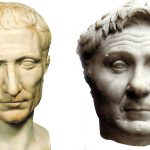Several large sculptures were among a treasure trove of artifacts recovered by divers from the waters near Alexandria, Egypt.
A collection of ancient statues, coins, pottery, and fragments of a merchant ship have been recovered from the waters off the coast of Alexandria, Egypt. Officials say the area may have been an extension of Canopia, an ancient city near Alexandria. The objects date back to the Egyptian Ptolemaic dynasty, which ruled from 305 to 30 BCE, and the Roman period, which ended in 642 CE. The artifacts provide new evidence that the area was “prosperous and flourishing” during this period.
Alexander the Great founded the ancient city on Egypt’s northern coast in 332 BCE. So how did these artifacts end up at the bottom of the Mediterranean Sea? Historians believe rising sea levels and earthquakes flooded Canopia—along with the nearby port city of Thonis-Heraklion—around 1,200 years ago. The ruins of the city have remained underwater ever since. During the search, divers recovered several large statues, although many were severely damaged.
The team discovered a granite effigy of an unknown member of the Ptolemaic dynasty, missing its head, and the lower half of a white marble sculpture of a Roman elite. Another statue, depicting a sphinx, bears the cartouche of Ramesses II, who ruled from 1279 to 1213 BCE – the second-longest reign in ancient Egyptian history. Other discoveries included pottery, coins, and tanks used for water storage and fish farming. Divers also recovered fragments of limestone buildings that may have been homes, businesses, or places of worship. The excavations also revealed fragments of a merchant ship carrying almonds, walnuts, and copper scales. Stone anchors were found nearby, and officials believe the site once served as a harbor for small boats. However, the team left some of these items, including anchors, beneath the surface of the bay.







